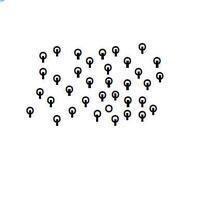We investigate reading strategies for node-link diagrams that wrap around the boundaries in a flattened torus topology by examining eye tracking data recorded in a previous controlled study. Prior work showed that torus drawing affords greater flexibility in clutter reduction than traditional node-link representations, but impedes link-and-path exploration tasks, while repeating tiles around boundaries aids comprehension. However, it remains unclear what strategies users apply in different wrapping settings. This is important for design implications for future work on more effective wrapped visualizations for network applications, and cyclic data that could benefit from wrapping. We perform visual-exploratory data analysis of gaze data, and conduct statistical tests derived from the patterns identified. Results show distinguishable gaze behaviors, with more visual glances and transitions between areas of interest in the non-replicated layout. Full-context has more successful visual searches than partial-context, but the gaze allocation indicates that the layout could be more space-efficient.
翻译:我们通过研究先前进行的眼动追踪实验记录的数据,探究如何在扁平化的环面拓扑结构中阅读节点-链接图。早期的工作表明,与传统的节点-链接表示相比,环面绘图能够提供更大的灵活性以减少混乱,但阻碍了链接-路径的探索任务,而在边界周围重复的平铺则有助于理解。然而,目前仍不清楚用户在不同环绕设置下采用哪些策略。这对于未来更有效的网络应用和从循环数据中获取的包裹视图的设计影响至关重要。我们对凝视数据进行了视觉探索数据分析,并进行了从已识别的模式中得出的统计检验。结果显示出可区分的凝视行为,非重复布局中有更多的视觉瞥见和区域间的转换。全上下文比部分上下文更成功地进行了视觉搜索,但凝视分配表明布局可能更具空间效率。

